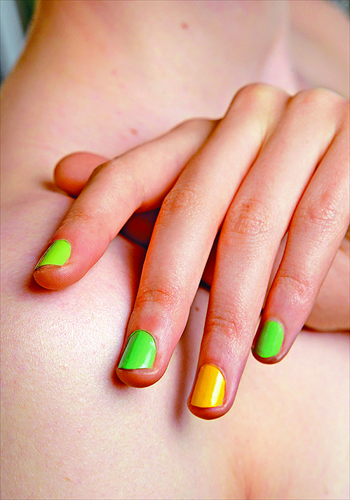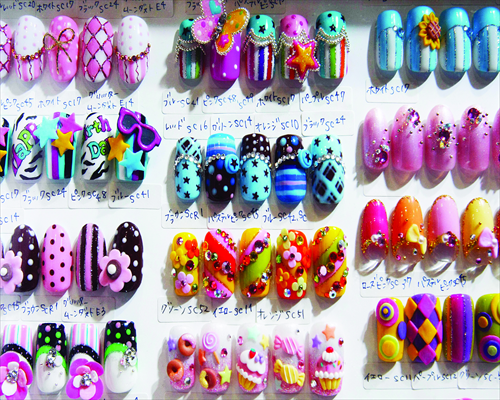Finger fashion tips


Samples of nail art displayed at the Tokyo International Nail Expo in November 2010 Photos: IC
It's summer time! That means it's time for young ladies to show off their slim body lines, tanned skin and beautifully painted finger and toenails.
Nail beauty salons have been around for as long as facial and body beauty salons. Despite the industry's long existence, it is still experiencing a period of rapid growth in the Chinese mainland. And interestingly, while nail beauty is loved by women all around the world, consumers in the East and West often show different preferences in style.
An ancient industry
Commercialized manicures and pedicures are a modern day phenomenon, but the history of women's nail beauty can be dated back to hundreds and thousands of years ago in both Eastern and Western cultures.
In ancient China, a pair of beautiful hands was often a sign of high social status. Without many choices available for dying materials, balsamine flowers were often mashed and their juice was applied to dye the nails a deep red color. But don't picture the tidy short nails of today: in the past, the nails were often kept long to appear elegant.
The custom of keeping extremely long nails is described in many ancient Chinese poems as well as other literary categories.
When it comes to the Qing Dynasty (1644-1911), luxurious nail wraps were commonly used among the imperial women.
A similar trend in nail beauty also started among ancient Egyptians several thousand years ago. There, the different nail colors symbolized different social status.
Modern manicures began in the 19th century when orange wooden sticks were created as tools for giving a manicure. And as new paints were used in the early 20th century, the trend developed fast in the US. And as for styles during the late 19th and early 20th centuries, besides going for a painted look, a clear shiny nail polish was favored.
Modern style
Today's manicure has developed in aspects from nail shapes, materials, and styles. While the nails can be shaped into oval, square oval, pointed, almond, round, and square, nail polishes are no longer the only material to go on them. Customers can also have acrylic resin or nail gel, which are able to last for weeks. In addition, there is no need for women to wait for what seems like ages for their nails to grow longer, as nail tips are able to "extend" the nails.
If one is not satisfied with just colored nails, they may now choose rhinestones, dangles, stickers or glitter to make the nails look more glamorous. Or, some may prefer pictures or designs drawn on their nails.
At the forefront of fashion, stars often play an important role. For example, the French manicure - a style that is designed to resemble natural nails by leaving the base color clear or natural pink with the nail tips painted white - was made popular by Hollywood stars. It's said they were looking for a nail lacquer that could fit their entire wardrobe.
In Asia, Japanese singer Hamasaki Ayumi and Chinese Taiwan singer Jolin Tsai are without a doubt leading figures in the regional nail beauty trend. Their remarkable styles are often made more complicated with rhinestones and dangles.
East vs. West
Though the worldwide trend of women splurging on manicures and pedicures has developed into more than a commercial industry but also an art, the preference of styles differ strikingly between East and West.
Erica Weng, a Chinese nail technician who works in Canada, told the Global Times that while women in Europe and North America prefer a simpler style, such as French or single color, Asian customers mainly follow the Japanese trend, which leans heavily toward more delicate and fancy styles.
"Europeans and Americans are fond of bolder color, exaggerated style and painting. But Japanese, Koreans and Chinese use more UV gel for light, cute and shinning styles," Fei Min, a veteran nail technician in China said. She has collected a wider world view by talking with fellow technicians in different countries.
Sandy Hsieh, an American-born Chinese who now works in Beijing, said since moving to China she has tried many manicure styles. Her feeling is that "China is more efficient and flexible than the US in the styles they provide. They are also more creative and artistic." In her opinion, the different preference has to do with the general fashion culture of each society along with clothing styles and so on.
As a customer, Hsieh thinks highly of Japanese nail art, which is practiced in China, while Weng pointed out Japan demands the highest level of skills and aesthetics for its nail technicians.
"Most of the nail technicians in Japan are qualified with certificates, which range from junior, middle and senior. But in North America, there aren't," Weng said.